android / AIDL - Kaleidescope
Marcel Braghetto 1 November 2015

Get the source for this example here
If you’d like to try it out on your device:
- Download and install AIDL-Kaleidoscope-Remote.apk
- Download and install AIDL-Kaleidoscope-Local.apk
I wanted to play around with AIDL - Android Interface Definition Language to test out how it can be used to communicate between two (or more I guess) Android processes at run time.
I found that there is more than one way to do Inter Process Communication (IPC) on Android, but I wanted to focus on the scenario of two completely different APKs talking to each other, via a contract defined using AIDL.
The use of AIDL to define a contract for communication within Android processes requires us to use bound services through a connection’s binder. You can do IPC without directly using AIDL at all, but that isn’t the focus of this demo. You could also use IPC mechanisms to communicate between different processes within the same Android app.
Key goals for this demo:
- Create a local application and a remote application which have AIDL contract interfaces that can be used to send commands between them.
- Our local application will allow us to draw on the screen, and will use the AIDL contract to forward the drawing commands to the remote application process.
- The remote application process will perform its own transformations on the actions it receives and call back via the AIDL contract to the local process with drawing commands of its own!
The idea is that the remote process will take the drawing commands it is given and do something to make some kind of kaleidoscope effect (Warning: the effect is really lame in this demo!).
The overall loop of communication will be:
- Local sends drawing commands via AIDL to Remote.
- Remote translates drawing commands.
- Remote sends drawing commands via AIDL back to Local.
Here is a quick diagram of what we will construct:
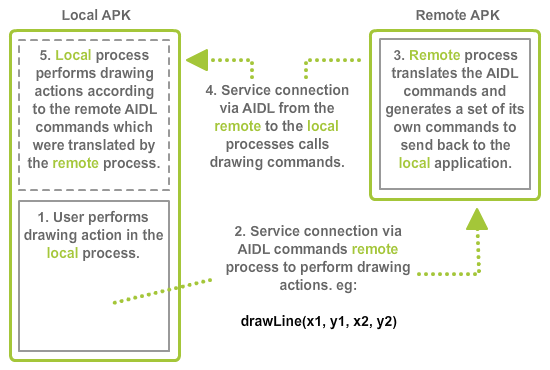
Onward we go!
1. Building the local application
The local application is pretty basic, really there are just a couple of new things to do after generating a default Android Studio project:
1a. Create a new AIDL interface contract
After creating a new project, (I named this project Local - you can refactor the default app module name), add a new AIDL file and name it IKaleidoscopeInterface as so:
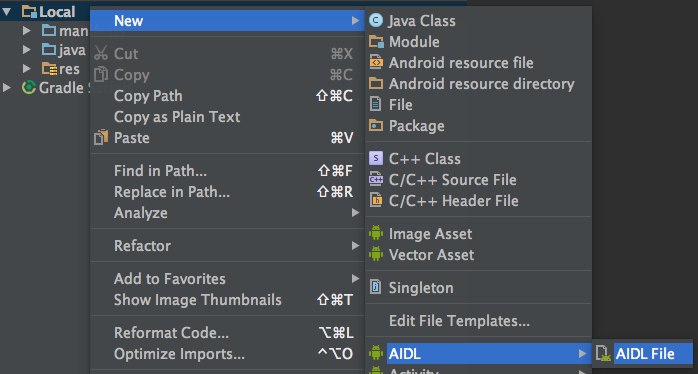

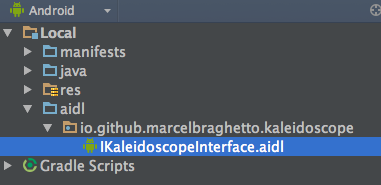
Our AIDL interface is the key to communicating between processes. Only the methods in this interface may be invoked and the set of data types you can use is limited. See the Android Developer resources for more info.
For our interface we want to do a one thing: Draw a line between two points.
Edit the AIDL interface to reflect this:
interface IKaleidoscopeInterface {
/**
* Request that a line be drawn between the
* two given coordinates.
*/
void drawLine(int x1, int y1, int x2, int y2);
}
1b. Create a service that can be invoked by the remote process
In order for the remote process to send commands back to our local application, we must provide a service that meets the requirements of the AIDL contract we wrote.
When something tries to bind to the service, it will be returned an implementation of our AIDL contract as the binder.
Cool tip: If your intellisense can’t find the IKaleidoscopeInterface class, you most likely need to perform a Gradle Sync so the AIDL file code generation is triggered.
LocalKaleidoscopeService.java
package io.github.marcelbraghetto.kaleidoscope.local;
public class LocalKaleidoscopeService extends Service {
@Nullable
@Override
public IBinder onBind(Intent intent) {
return mKaleidoscopeInterface.asBinder();
}
/**
* This is the secret sauce, our service will create an implementation of
* the AIDL contract 'stub' which can then be returned as the 'binder'
* when the 'onBind' method is invoked on the service.
*
* When the consumer of the service is connected and invokes methods via
* AIDL, this is where they will be executed.
*/
private final IKaleidoscopeInterface mKaleidoscopeInterface = new IKaleidoscopeInterface.Stub() {
@Override
public void drawLine(int x1, int y1, int x2, int y2) throws RemoteException {
// TODO: Do something with the received action!
}
};
}
The key part of the code above is that when something tries to bind to our local service, the onBind method will be invoked and we will return an implementation of the AIDL contract. This allows a remote process to consume our service and talk via AIDL to us!
You may notice that we are creating an implementation of IKaleidoscopeInterface.Stub() - Android generates the Stub() method as part of AIDL.
1c. Expose the new local service
Our new LocalKaleidoscopeService can’t be accessed as a service just yet because we haven’t put its declaration into the app manifest.
The local application needs to expose a service that meets the AIDL contract, so the remote process can bind to it. There is something to consider when doing this:
- A service when marked as exported = true or with an accessible intent-filter will have no permissions on it. This means anyone could really jack into your service which might be a security issue.
For this demo, we’ll add a basic custom permission that the service will require in order for something to bind to it.
AndroidManifest.xml
<permission
android:name="io.github.marcelbraghetto.kaleidoscope.local.LocalKaleidoscopeServicePermission"
android:protectionLevel="signature"
/>
<application>
<!-- Insert your other manifest config -->
<service
android:name=".LocalKaleidoscopeService"
android:exported="true"
android:permission="io.github.marcelbraghetto.kaleidoscope.local.LocalKaleidoscopeServicePermission">
<intent-filter>
<action android:name="LocalKaleidoscopeService" />
</intent-filter>
</service>
</application>
Note that we have added a custom permission named LocalKaleidoscopeServicePermission and that our service definition requires it. You may want to extend the permission implementation but I’ll keep it simple for this blog post.
The service definition will use the intent-filter with an action to allow itself to be accessed remotely. When we construct the remote application, it will use this service.
##2. Building the remote application
Next we’ll create the remote application, which will contain the remote service which our local application will bind and send AIDL commands to.
2a. Create remote module
Start by creating a new application module in Android Studio named Remote.
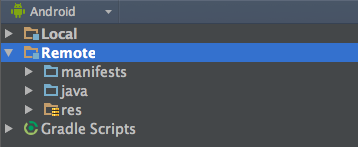
2b. Copy AIDL definition
We will be writing two way communication via the same AIDL interface contract, so the new remote app needs a copy of the exact same AIDL definition file that we used in the local app.
A simple way to do this is to go into Finder (or whatever file manager you use) and copy the src/main/aidl folder from the local app into the src/main folder in the remote app.
After doing this, trigger a Gradle Sync and you should see something similar to this:
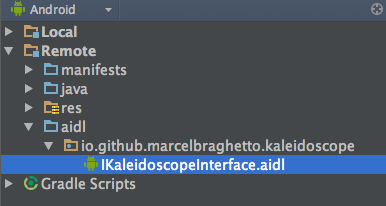
2c. Create remote service
The remote application will implement a service that implements our AIDL interface contract just like our local application did. The actual behaviour of the service implementation will be a bit different but the steps to follow are almost identical.
First, create the Java service in the remote application:
RemoteKaleidoscopeService.java
package io.github.marcelbraghetto.kaleidoscope.remote;
public class RemoteKaleidoscopeService extends Service {
@Nullable
@Override
public IBinder onBind(Intent intent) {
return mKaleidoscopeInterface.asBinder();
}
private IKaleidoscopeInterface mKaleidoscopeInterface = new IKaleidoscopeInterface.Stub() {
@Override
public void drawLine(int x1, int y1, int x2, int y2) throws RemoteException {
showToast("Remote: Received drawLine command");
}
};
private void showToast(final String message) {
new Handler(Looper.getMainLooper()).post(new Runnable() {
@Override
public void run() {
Toast.makeText(getApplicationContext(), message, Toast.LENGTH_SHORT).show();
}
});
}
}
At the moment we will just display a Toast message when any of the AIDL interface methods are invoked. We’ll revisit this later to do something more interesting but for now it will at least tell us that the AIDL communication is working.
2d. Expose the new remote service
Of course we have to expose the remote service in the manifest so it can be bound to by the local application:
<permission
android:name="io.github.marcelbraghetto.kaleidoscope.remote.RemoteKaleidoscopeServicePermission"
android:protectionLevel="signature"
/>
<application>
<!-- Insert your other manifest config -->
<service
android:name=".RemoteKaleidoscopeService"
android:exported="true"
android:permission="io.github.marcelbraghetto.kaleidoscope.remote.RemoteKaleidoscopeServicePermission">
<intent-filter>
<action android:name="RemoteKaleidoscopeService" />
</intent-filter>
</service>
</application>
The configuration is very similar to what we did earlier for the local application.
Build and run the remote application so it is installed on your test device and is ready to have its service bound, ready for the next part.
##3. Bind to the remote service
Now that we have a remote service available, we can revisit the local application and bind to it. This will allow us to start sending AIDL commands to the remote service finally - woohoo!!
3a. Register remote service permission
Remember how we put in basic permissions for our exposed services (if not then you weren’t paying attention!)? Well, in order to bind to a service that needs a permission, we have to add the permission as a uses-permission clause in our manifest which matches the permission defined in the remote app manifest.
Edit the manifest for the local application and add a new line, above the existing permission line:
<uses-permission android:name="io.github.marcelbraghetto.kaleidoscope.remote.RemoteKaleidoscopeServicePermission" />
If you don’t do this, you will get a security exception when you try to bind to the service!
3b. Bind a connection to the remote service
Ok, finally we get to write some actual Java code to use the services we created. To bind a connection to our remote service we need to follow the following steps:
3c. Create a field reference to our AIDL interface
During the binding of the remote service, we will be assigning the IBinder parameter that is given to us to a local field of type IKaleidoscopeInterface which will then become our bridge to sending commands to the bound service.
We also need to create and hold an instance of a ServiceConnection which will be used during the binding (and unbinding) and who will initialize the reference to our AIDL interface instance.
MainActivity.java
public class MainActivity extends AppCompatActivity {
private boolean mIsRemoteKaleidoscopeInterfaceBound;
private IKaleidoscopeInterface mRemoteKaleidoscopeInterface;
...
private final ServiceConnection mRemoteServiceConnection = new ServiceConnection() {
@Override
public void onServiceConnected(ComponentName name, IBinder service) {
// Note how we are using the AIDL Stub.asInterface to map the
// provided IBinder to our AIDL interface.
mRemoteKaleidoscopeInterface = IKaleidoscopeInterface.Stub.asInterface(service);
mIsRemoteKaleidoscopeInterfaceBound = true;
}
@Override
public void onServiceDisconnected(ComponentName name) {
mRemoteKaleidoscopeInterface = null;
mIsRemoteKaleidoscopeInterfaceBound = false;
}
};
}
3d. Start the intent to bind the remote service
Now that we have a few fields in place we can actually attempt to bind to the remote service. We’ll do this when the activity is created.
This was actually quite tricky to get working correctly, the ability to a bind a service through an implicit intent was prohibited starting in Android Lollipop (5.0).
The problem is that we don’t have any access to the actual Java class in the remote application so we can’t create an explicit intent easily, for example:
// This code will not compile from within the local application project
// because the RemoteKaleidoscopeService.java class is not in it's
// source path (nor should it be).
Intent intent = new Intent(this, RemoteKaleidoscopeService.class);
Hmm, what to do about that… well I discovered a way to still do it by getting Android to help us to create an explicit intent instead by using the remote intent-filter action and querying its properties.
private Intent createRemoteServiceIntent() {
// Create a basic intent using the intent filter action of
// the remote service as per its manifest configuration.
Intent intent = new Intent("RemoteKaleidoscopeService");
// Attempt to resolve the service through the Android OS
ResolveInfo info = getPackageManager().resolveService(intent, Context.BIND_AUTO_CREATE);
// If the service failed to resolve it could mean that the
// remote app is not installed or something wasn't configured
// correctly, so we can't really start/bind the service...
if(info == null) {
return null;
}
// Otherwise, grab the resolved package name and service name and
// assign them to the intent and bingo we have an explicit service intent!
intent.setComponent(new ComponentName(info.serviceInfo.packageName, info.serviceInfo.name));
return intent;
}
Sweet, so now we can bind the connection - and when the activity is destroyed we should unbind it:
MainActivity.java
@Override
protected void onCreate(Bundle savedInstanceState) {
...
Intent remoteServiceIntent = createRemoteServiceIntent();
if(remoteServiceIntent != null) {
bindService(remoteServiceIntent, mRemoteServiceConnection, Context.BIND_AUTO_CREATE);
}
}
@Override
protected void onDestroy() {
super.onDestroy();
if(mIsKaleidoscopeInterfaceBound) {
unbindService(mRemoteServiceConnection);
}
}
3d. Test the connection
Ok, you’ve been hanging in there through this colossal wall of text, so let’s actually see the connection working. To test it out, we’ll write a method to send a drawLine command to the remote service.
For now, I’ll just drop a button into the main activity and fire the command when it is clicked. I won’t bore you with the button code - I’m sure you can do that, but here is the code to send the command to the remote service:
private void sendDrawLineCommand() {
// Don't bother sending the command if we are
// not yet bound to the service.
if(mIsRemoteKaleidoscopeInterfaceBound) {
// Calling AIDL methods can cause a RemoteException
// it's up to you how you deal with it...
try {
mRemoteKaleidoscopeInterface.drawLine(1, 1, 2, 2);
} catch (RemoteException e) {
e.printStackTrace();
}
}
}
The following image is an example of what happens when this code runs. The interesting thing to note is that the Toast message being displayed is actually coming from the remote service! This means we finally have our service connection running via AIDL!!!
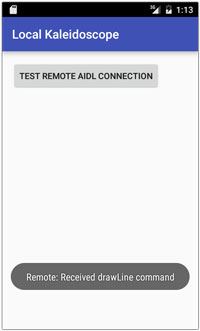
4. Back the other way
You might recall that at the start of this blog post, we created an AIDL service for the local app. We haven’t yet used it but the goal was to have two way AIDL communication running.
So far we have one way communication, where the local application can send AIDL commands to the remote service. The next step is to have the remote service send commands back to the local application via the local service we wrote earlier.
4a. Binding to the local service
The remote service will need to bind itself to our local service in order to send commands back. The subtle difference here is that the local app is currently binding a service connection in an activity, whereas the remote app will need to bind it within its own service!
First off, we need to register the permission needed to use the local AIDL service. Edit the manifest in the remote app and add the following uses-permission clause:
<uses-permission android:name="io.github.marcelbraghetto.kaleidoscope.local.LocalKaleidoscopeServicePermission" />
Then edit the existing RemoteKaleidoscopeService.java class.
Similar to before, we need a few fields to hold our AIDL interface reference and ServiceConnection instance.
To make things clear, I’ve included the entire class below, as you can see, the service will now attempt to connect back to the local service and effectively route all AIDL commands to the local service.
RemoteKaleidoscopeService.java
public class RemoteKaleidoscopeService extends Service {
private boolean mIsLocalKaleidoscopeInterfaceBound;
private IKaleidoscopeInterface mLocalKaleidoscopeInterface;
@Override
public void onCreate() {
super.onCreate();
Intent localServiceIntent = createLocalServiceIntent();
if(localServiceIntent != null) {
bindService(localServiceIntent, mLocalServiceConnection, Context.BIND_AUTO_CREATE);
}
}
@Override
public void onDestroy() {
super.onDestroy();
if(mIsLocalKaleidoscopeInterfaceBound) {
unbindService(mLocalServiceConnection);
}
}
@Nullable
@Override
public IBinder onBind(Intent intent) {
return mKaleidoscopeInterface.asBinder();
}
private IKaleidoscopeInterface mKaleidoscopeInterface = new IKaleidoscopeInterface.Stub() {
@Override
public void drawLine(int x1, int y1, int x2, int y2) throws RemoteException {
if(mIsLocalKaleidoscopeInterfaceBound) {
try {
mLocalKaleidoscopeInterface.drawLine(x1, y1, x2, y2);
} catch (RemoteException e) {
e.printStackTrace();
}
}
}
};
private Intent createLocalServiceIntent() {
// Create a basic intent using the intent filter action of
// the local service as per its manifest configuration.
Intent intent = new Intent("LocalKaleidoscopeService");
// Attempt to resolve the service through the Android OS
ResolveInfo info = getPackageManager().resolveService(intent, Context.BIND_AUTO_CREATE);
// If the service failed to resolve it could mean that the
// remote app is not installed or something wasn't configured
// correctly, so we can't really start/bind the service...
if(info == null) {
return null;
}
// Otherwise, grab the resolved package name and service name and
// assign them to the intent and bingo we have an explicit service intent!
intent.setComponent(new ComponentName(info.serviceInfo.packageName, info.serviceInfo.name));
return intent;
}
private ServiceConnection mLocalServiceConnection = new ServiceConnection() {
@Override
public void onServiceConnected(ComponentName name, IBinder service) {
mLocalKaleidoscopeInterface = IKaleidoscopeInterface.Stub.asInterface(service);
mIsLocalKaleidoscopeInterfaceBound = true;
}
@Override
public void onServiceDisconnected(ComponentName name) {
mLocalKaleidoscopeInterface = null;
mIsLocalKaleidoscopeInterfaceBound = false;
}
};
}
Cool, now run and deploy the updated remote app. Although we can’t see it yet, the AIDL commands are going from the local app to the remote service, then back to the local app service.
Let’s revisit the local app and have it respond to its own AIDL service commands!
4b. Update local app and service
Our local app activity will listen for broadcast events that we will emit from the LocalKaleidoscopeService when it receives AIDL commands from the remote service.
A pure Android approach to this would be to use a LocalBroadcastReceiver, through which the local service will broadcast its AIDL commands as it receives them. Thats all well and good but its a bit cumbersome so I’ll be using the EventBus library by Green Robot instead of the built in Android system.
Follow the directions on the GitHub page for EventBus to get the library into your app.
I’ll be creating a new event that is broadcast whenever our AIDL commands are received, which the main activity will listen for. Note that for simplicity this class has public fields instead of getters etc.
Move back to the local app again and create a new class for our event:
DrawLineEvent.java
public class DrawLineEvent {
public int x1;
public int y1;
public int x2;
public int y2;
public DrawLineEvent(int x1, int y1, int x2, int y2) {
this.x1 = x1;
this.y1 = y1;
this.x2 = x2;
this.y2 = y2;
}
}
Then in your MainActivity add the following methods:
@Override
protected void onResume() {
super.onResume();
EventBus.getDefault().register(this);
}
@Override
protected void onPause() {
super.onPause();
EventBus.getDefault().unregister(this);
}
@SuppressWarnings("unused")
public void onEventMainThread(@NonNull DrawLineEvent event) {
Toast.makeText(this, "Local Main Activity received DrawLineEvent!", Toast.LENGTH_SHORT).show();
}
Basically we are just subscribing to the event bus in onResume and unsubscribing in onPause. Any time something broadcasts an instance of the DrawLineEvent class, we will receive it.
4c. Broadcasting the AIDL events
Edit the existing LocalKaleidoscopeService class and instead of displaying a Toast, we’ll get it to use the EventBus to broadcast the event:
LocalKaleidoscopeService.java
...
private final IKaleidoscopeInterface mKaleidescopeInterface = new IKaleidoscopeInterface.Stub() {
@Override
public void drawLine(int x1, int y1, int x2, int y2) throws RemoteException {
EventBus.getDefault().post(new DrawLineEvent(x1, y1, x2, y2));
}
};
Sweet, now run the updated local app again and you should be seeing the Toast message generated directly from the main activity (not the service itself) proving that:
- The local activity received the EventBus broadcast from the local service; because
- the local service received an AIDL command and then broadcast it as an event; because
- the remote service sent an AIDL command to the local service; because
- the remote service received an AIDL command from the local application; because
- the local application sent an AIDL command to the remote service; because
- we clicked a button…
Did that completely do your head in or what!?? But its pretty damn cool if you ask me!
##5. Where’s the colours!??
Ok so this whole blog post is called AIDL Kaleidoscope but so far I have failed to impress you with anything graphically interesting at all.
The core purpose of this blog post was to explore and illustrate the use of AIDL interfaces to allow cross process / application communication - a form of IPC.
So I guess now that all the boring theory is out of the way, we can have a bit of fun and try to make a not-too-lame graphical visualisation of what we have constructed.
I won’t walk through the actual code for the next steps because it isn’t inherently about AIDL, but you can find all the source code in the GitHub page for this blog post.
Here is a quick overview of the kaleidoscope idea though:
- The user draws on the screen.
- As the user draws, the drawLine AIDL commands are sent to the remote service.
- The remote service will then mutate the drawing commands and relay them back in a different way.
- The remote service will try to do something to cause the local app to render the drawn lines in a kaleidoscope fashion - mirrored copies of the original drawing commands.
Ok so the actual kaleidoscope effect ended up a bit lame but here is a preview of what it looks like:

##6. Final thoughts
This was a fun exercise for me, trying out some techniques that are not typically part of my day to day Android development. I failed pretty hard on getting a convincing kaleidoscope visual effect, but the focus of this blog post was IPC via AIDL communication.
Some random thoughts:
- IPC via AIDL is not extremely difficult - you just need to make sure things are lined up the correct way in the manifest entries.
- In a way it’s kinda like a giant dependency injection system - once the remote service is deployed, it can be updated as many times as needed with different implementations of the AIDL interfaces and the consuming applications never need to be updated.
- It would be a great vehicle for distributing work tasks amongst different processes, each of which could hold specific responsibility over its domain, again in a DI kinda way it could allow for hot swapping implementations.
- For applications with a common suite or with related product value, it could provide a way to integrate them together at a fairly deep level - and give the end user a seamless experience across the product suite.
Enjoy!
.:: END ::.









